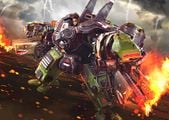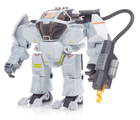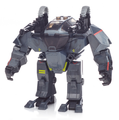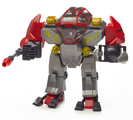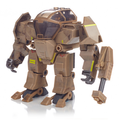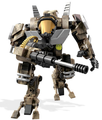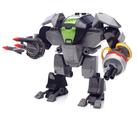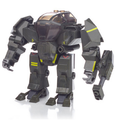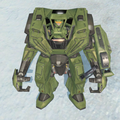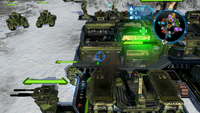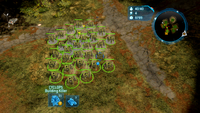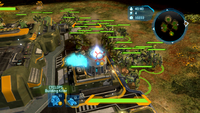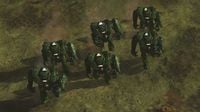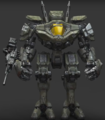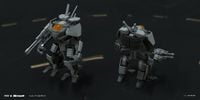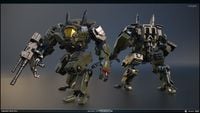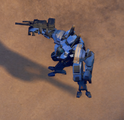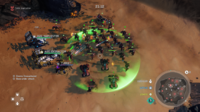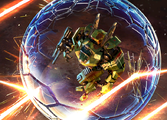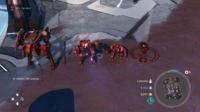HRUNTING Mark III (B) Cyclops
From Halopedia, the Halo wiki
| HRUNTING Mark III Exoskeleton | |
|---|---|
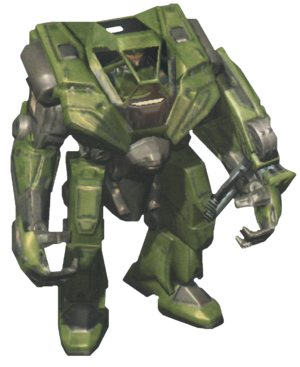
| |
| Production information | |
|
Manufacturer: |
|
|
Product line: |
HRUNTING |
|
Model: |
Mark III |
| Technical specifications | |
|
Width: |
3.7 meters (11.7 feet)[1] |
|
Height: |
4.3 meters (14.2 feet)[1] |
|
Maximum speed: |
48 kilometers per hour (30 mph)[2] |
|
Armament: |
1 Anti-structure titanium-enriched jackhammer and piledriver; manipulator units (standard) |
|
Crew: |
One operator[1] |
| Usage | |
|
Year introduced: |
|
|
Role(s): |
Military engineering vehicle, logistical support, structure demolition |
|
Affiliation: |
|
- "You sending a vehicle after me? Suckers."
- — A Cyclops pilot during the Second Ark Conflict.[3]
The HRUNTING Mark III Exoskeleton, also known as the Cyclops, is a bipedal powered exoskeleton used by the United Nations Space Command.[2] It is a redesigned version of the Mark III exoskeleton, a predecessor to the MJOLNIR Powered Assault Armor.[1]
Overview
Development history
Unlike the form-fitting armored suits that began with the retroactively named Mark IV, the predecessors of MJOLNIR were bulky powered exoskeletons. In 2511, Dr. Catherine Halsey decided to scrap the earlier iterations due to their size, lack of maneuverability, and power inefficiency. She and the Office of Naval Intelligence's Materials Group abandoned the exoskeletons for Project: MJOLNIR, leaving most of the exoskeletons (even the comparatively successful Mark IIIs, which had been introduced only a year earlier) in Reach's titanium mines.[4][5]
In 2513, the Materials Group's research team on Algolis, who were working on a separate project known as "HRUNTING", began to refine the Mark III. Working at Weapons Research Facility T12A, the HRUNTING team made their own development breakthroughs until they created a revised "[B]" variant of the Mark III, which they called the Cyclops. Unlike the original Mark I, II, and III exoskeletons, the Mark III [B] was intended to perform non-combat military roles such as construction, matériel transportation, terraforming, and dock work. The Cyclops eventually saw limited deployment as a logistical support unit with the Marine Corps. Operators were forced into combat on rare occasions, during which the Cyclops proved very effective as an ad hoc anti-matériel and anti-fortification platform.[1]
Numerous variants of the Cyclops have been designed since the introduction of the Mark III [B], including some versions that are armed and up-armored; others are marketed toward civilian agencies.[2] Following the development of the Cyclops the HRUNTING project was merged with the similarly oriented YGGDRASIL project, resulting in the creation of several exoskeletons and armor defense systems beginning with the Mark I Armor Defense System.[6]
Cyclops aboard the UNSC Spirit of Fire were radically redesigned by the Smart AI Serina using design files from Lethbridge Industrial that she came across during the Battle for Arcadia. The Cyclops produced aboard the Spirit of Fire after 2531 used a refactored exoskeleton and completely original control software. Though the anti-tank Cyclops did not have the raw strength of the original engineering vehicle, it was faster and far easier to operate even with its new weaponry and armor. Isabel continues to improve on the design with modern UNSC cyberlink protocols and module concepts.[7]
Design
The Cyclops is a very large platform, standing 4.3 meters (14.1 feet) tall and 3.7 meters (12.1 feet) wide.[1] The operator is harnessed within a sealed cockpit that features a transparent canopy and a roll cage. In order to make controlling the Cyclops feel more natural the operator is encased in an internal active-impedance haptic interface exoskeleton that controls the movement of the vehicle itself and provides force feedback. As a result the Cyclops feels like an extension of the operator's body despite not being "worn" in the same sense as smaller powered exoskeletons such as MJOLNIR.[2]
The Cyclops' most prominent feature is its two large arms, which feature powerful hand-like torque-amplification gauntlets. These manipulators can effortlessly crush a Sangheili's body and, with the assistance of a wrist-mounted pile driver, can shear large pieces from Wraith tanks and even citadels, the latter of which possess starship-grade armor plating. In keeping with its intended role as a support unit the Cyclops can use its manipulators and various arm-mounted tools to repair vehicles and structures. Due to the Cyclops' nimble design these repairs can be completed very quickly, even in the field.[8]
The Cyclops is surprisingly lightweight for its size thanks to the advanced materials created by the engineers and scientists on Algolis.[2] It is also quite agile, capable of outpacing even Spartan-IIs at a speed of just over 48 kilometers per hour (30 mph).[2] Hydraulic-buffered shocks in the exoskeleton's feet ensure that rough terrain does not hinder the mobility of the Cyclops and allow it to jump short distances.[8] Like the original Mark III exoskeleton the Cyclops features an externally mounted fusion reactor as its power supply,[8] though the unofficial Mark III [B-II] variant often replaces the standard reactor with an alternate power source.[2]
Models
The Cyclops' ease of use and load carrying capacity have led to the creation of numerous iterations of it as of 2558:
- Mark III [A]: The initial prototype of the Cyclops, this model is equipped with neural interface controls and features a sealed canopy used as an armored carapace.[2]
- Mark III [B]: This is the initial, unarmed production variant used for structural demolition[2] and logistical support.[1]
- Mark III [B-II]: An unofficially designed variant of the [B] model, this exoskeleton features redesigned feet and a more robust, sealed cockpit. Many are equipped with alternate power-packs that replace the expensive fusion generator with hydrogen-burning turbines or high-density power cells.[2]
- Mark III [B1]: An upgrade to the [B] model, this variant is produced by Hannibal Weapon Systems. It features composite armor plating and hardpoints for weapon installation. This model is popular with paramilitary security forces on the cities of Earth.[2]
- Mark III [M1]: Produced by Lethbridge Industrial, this variant is armed and are used as multi-purpose assault platforms with heavy weapon hardpoints installed on the "shoulders". They are protected by Titanium-A armor plating. This variant is currently undergoing field trials with the UNSC Army.[2]
Variants
There are several minor Cyclops variants with no official categorizations. Most of these variants follow common themes in terms of their loadout and the scope of their modification. Some alterations are made to enhance their suitability in specific climates. The following are variants in service as of 2559:
- Serina's Cyclops: Cyclops aboard the UNSC Spirit of Fire modified by Serina for anti-tank roles. The autocannon can be upgraded to fire shock rounds with non-nuclear electromagnetic pulse warheads that slow the movement of target vehicles.
- Kinsano's Cyclops: a variant designed for Morgan Kinsano featuring dual M7057 flamethrowers.[9]
- Peacekeeper: Commonly used by law enforcement SWAT teams in the megacities of Earth, this variant is a essentially a Mark III [A] unit equipped with a riot-control shield. It also mounts a low-pressure autocannon capable of firing a variety of less-lethal munitions. Most Peacekeepers were destroyed when they were pressed into active combat duty.[2]
- Protector: Usually derived from older B-II units, Protectors are deployed in high-threat civil rescue missions. They are often operated by firefighters and medical response teams for deployment in situations where larger vehicles cannot fit, and protect workers from high-risk environments. They are usually configured with a large tank of fire-retardant foam, a high-pressure projector, and a high-torque gripping arm for ripping apart damaged vehicles to reach occupants trapped inside or to break the reinforced walls that are generally found in arcologies.[2]
- Breaker: These units are used for ship-breaking and construction. They are equipped with specialized tools such as high-power plasma-cutters, hydraulic rams, or an assortment of cutting blades that allow them to complete their tasks. The Breaker allows individuals to safely take apart shattered ship hulks and stations that remain in orbit around a planet. They are also used for excavating half-melted buildings on the surface of glassed colonies.[2]
- Hazops: This variant features a biological laboratory-grade environmental sealing and a heavy flamethrower. Hazops units are occasionally assigned as support vehicles to Spartan assessment and containment teams at Forerunner sites which are believed to house Flood samples. When Flood spores are found by these units, it is often necessary to destroy the entire exoskeleton, as cleaning the whole suit for traces of the Flood supercell is extremely challenging. Although only explored in simulations, some believe it is possible for the Flood to take control of the suit and its operator and further augment the exoskeleton.[2]
- Arctic Cyclops: This variant is outfitted with arctic insulation and camo for military manoeuvres in sub-zero climates. It has a wrist mounted flamethrower, and can easily smash ice and snow.[10]
- Attack Cyclops: This variant is outfitted for special military maneuvers deep behind enemy lines. It is equipped with dual M12s.[11]
- Damage Control Cyclops: This variant is equipped to handle on-ship emergencies and comes outfitted with buildable claws and fire-suppression tanks.[12]
- Desert Cyclops: This variant is equipped for maneuvers in desert climates.[13]
- Desert Sniper Cyclops: Designed for desert duty alongside Marine units, this variant comes outfitted for a long-range sniper strike using the oversized arm-mounted sniper gun.[14]
- Heavy Assault Cyclops: This variant features a missile pod.[15]
- Incinerator Cyclops: This variant features an arm-mounted flame cannon.[16]
- Jungle Cyclops: This variant is equipped for maneuvers in tropical climates.[17]
- Offworld Cyclops: In order to recover valuable assets and technology from UNSC and Covenant vessels that were destroyed and left hanging in orbit high above the surfaces of human colonies, the UNSC deploys the Offworld Cyclops into the harsh conditions of space, giving the operator access to these harrowing debris fields. These Cyclopes utilize a high-tension energy blow torch in order to bore through or break apart rubble in order to acquire whatever their operators seek.[18]
- Sector 12 Police Cyclops: This variant is utilized by the New Mombasa Police Department. It features a heavy machine gun and a riot shield.[19]
- Zombie Containment Cyclops: This variant has an arm mounted energy cannon.[20]
- Corporate Security Cyclops: This variant is employed by Liang-Dortmund Corporation on Meridian.[21]
Operational history
Cyclopes were used during the Battle of the Etran Harborage to repair the UNSC Spirit of Fire's power core after it was damaged during a collision with a Covenant CPV-class heavy destroyer.[22] The UNSC Pillar of Autumn also had its own complement, which were used on Installation 04 after it landed on the ring in 2552. During the Second Ark Conflict, the crew of the UNSC Spirit of Fire used modified Cyclops to combat Banished forces.[3]
Gameplay
Halo Wars
The Mark III [B] Cyclops is a playable unit in Halo Wars. In the campaign, the Cyclops appears only in the level Repairs, but can be built by a second player in some missions in Co-op. In skirmish and multiplayer, the Cyclops is available only if Sergeant Forge is the player's selected hero unit. The Cyclops is designed to be an anti-structure unit with only melee attacks, and cannot attack aircraft.
The Cyclops requires 125 resource units, a tech level of one, one population slot, and can be built at the Firebase. It has the following upgrades:
- Repair Kit - Allows the Cyclops to repair buildings and ground vehicles. The upgrade costs 400 resource units and requires a tech level of two.
- High-Torque Joint - Improves the Cyclops' movement speed. The upgrade costs 900 resource units and requires a tech level of three.[23]
Halo Wars 2
Cyclops
- Info: Anti-Vehicle, Fast moving, Heavy armor, Cannot attack air
- Tier: 2
- Cost: Population 4, Supplies 120, Power 120
Cyclops upgrade: Shock rounds
- Info: Weapon upgrade, Shots slow vehicles, Increased damage
- Tier: 3
- Cost: Supplies 0, Power 700
Unlike its Halo Wars counterpart, the Cyclops in Halo Wars 2 is an anti-vehicle unit armed with a gun, though it still cannot attack aircraft, and only does okay against structures and poorly against infantry. In addition, the Cyclops is no longer able to repair ground vehicles and structures; this role is instead filled by the Nightingale. The Cyclops can be built at the Barracks by all UNSC leaders.[3] In Blitz, Cyclops cost 30 energy, Reactive Cyclops cost 50 energy, and a Veteran Cyclops cost 70 energy. Morgan Kinsano has her own personal Cyclops equipped with dual M7057 Flamethrowers.
Production notes

|
Browse more images in this article's gallery page. |
- The Cyclopes are a race of one-eyed giants in Greek mythology. This Cyclops resembles them by its huge stature and visor in the center of its "head" resembling a single eye. Hrunting is a magical sword given to Beowulf in the Anglo-Saxon poem of the same name. It had never failed in battle until Beowulf's fight with a dragon which ultimately resulted in the hero's death.
- From a gameplay perspective the Cyclops exoskeleton is based on the Cyclops unit from Ensemble Studios' game Age of Mythology. It is similarly a large unit that deals heavy melee damage. Their alternate attacks are also similar; when secondary ability bar has charged, the Cyclops will lift a nearby infantry unit and hurl it at the enemy forces for additional damage. In Halo Wars, the Cyclops' secondary ability allows it to tear a vehicle apart and hurl the chunks at enemy forces in a similar manner.[24]
Trivia
- Though the standard plural form of the mythological Cyclops is Cyclopes, UNSC personnel in Halo Wars consistently say "Cyclopses" instead. In Halo Wars 2, "Cyclops" is treated as both singular and plural.
- The Cyclops and the Gremlin are the only known UNSC vehicles named after mythological creatures. Most UNSC ground vehicles are named after real animals.
- During the development of Halo Wars, concept art and early in-game models of the Cyclops had a yellow polarized canopy rather than the transparent canopy used in the final game. This design feature was brought back in Halo Wars 2.
- The Cyclops' width of 11.7 feet refers to John-117's Spartan tag.
Non-canon background
Graeme Devine, the lead writer of Halo Wars, created a backstory for the Cyclops that is rife with continuity errors. This was made to provide narrative context for the game development team. However, Devine states on his blog that the background stories he created are "essentially fan fiction" and should not be regarded as canon.[25]
The essay states that the Marine Corps designed the Cyclops as a shock infantry platform to combat the Insurrectionists, and that the program competed with the "fledgling" Orbital Drop Shock Troopers. The Cyclops is said to have been removed from service after the initiation of the SPARTAN-III program. Canonically the Cyclops was originally produced as a support platform and the ODST had been in service for centuries. The SPARTAN-III program was top-secret and served an entirely different role from that of the Cyclops, so the activation of the Spartans would have no bearing on the platform's deployment.
Gallery
- 06 CYCLOPS.jpg
Cyclops unit info sheet for Halo Wars
- Cyclops-development.jpg
A development image of the Cyclops
Six Cyclops deployed onto Shield World 0459.
Render of the Cyclops for Know Your Enemy.
- HW2C-Cyclops.jpg
Concept art of the Cyclops for Halo Wars 2.
A Cyclops in Halo Wars 2 Open Beta.
Cyclops with a sniper and M9 Wolverine.
Decimus attacks a Cyclops in Halo Wars 2.
An army of Cyclops on Ashes.
Cyclops attack a cloaked Banished Outpost with the help of Wolverines and an M12G1 Warthog.
Comparison between the HRUNTING/YGGDRASIL Mark II (J) Colossus, Mantis, Cyclops, and HRUNTING/YGGDRASIL Mark I (J) Green Machine.
List of appearances
- Halo: The Flood (First appearance) (Identified in 2010 edition)
- Halo Wars (First identified as Cyclops)
- Halo: The Thursday War (Mentioned only)
- Know Your Enemy
- Halo Wars 2
- Halo: Official Spartan Field Manual
Sources
- ^ a b c d e f g h Halo: The Essential Visual Guide, page 44
- ^ a b c d e f g h i j k l m n o p q r s Halo Waypoint: Cyclops
- ^ a b c Halo Wars 2
- ^ Halo: The Fall of Reach, page ???
- ^ Dr. Halsey's personal journal
- ^ Halo 4: The Essential Visual Guide, page 111
- ^ Halo Wars 2: Phoenix Logs - Cyclops
- ^ a b c Halo Wars
- ^ YouTube: PAX East 2017 - Halo Wars 2 Panel
- ^ Megabloks - UNSC ARCTIC CYCLOPS
- ^ Megabloks - UNSC ATTACK CYCLOPS
- ^ Megabloks - DAMAGE CONTROL CYCLOPS
- ^ Megabloks - UNSC CYCLOPS DESERT STRIKE
- ^ Megabloks - DESERT SNIPER CYCLOPS
- ^ Megabloks - HEAVY ASSAULT CYCLOPS
- ^ Megabloks - INCINERATOR CYCLOPS
- ^ Megabloks - UNSC CYCLOPS JUNGLE STRIKE
- ^ Megabloks - UNSC OFFWORLD CYCLOPS
- ^ Megabloks - SECTOR 12 POLICE CYCLOPS
- ^ Megabloks - CONTAINMENT OUTPOST PATROL
- ^ Megabloks -Corporate Security Cyclops
- ^ Halo Wars, campaign mission Repairs
- ^ Halo Wars manual
- ^ List of units in the Age of Mythology series
- ^ Graeme Devine's blog - Cyclops


